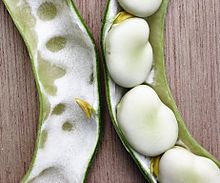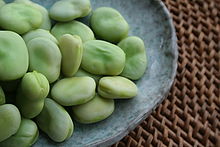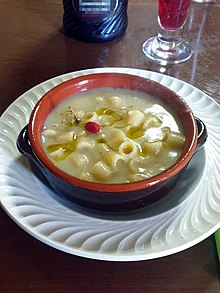Maccu


Maccu (also known as maccu di fave[1] and sometimes referred to as macco[2]) is a Sicilian soup and also a foodstuff that is prepared with dried and crushed fava beans (also known as broad beans) and fennel as primary ingredients.[3][4] Several dishes exist using maccu as a foodstuff, such as bruschetta al maccù and maccu di San Giuseppe, the latter of which may be served on Saint Joseph's Day in Sicily.
History
Maccu is a peasant food[1] and staple food that dates back to ancient history.[3][5][6] The ancient Roman people may have invented or introduced the foodstuff, which was created from crushed fava beans.[6] Although maccu's availability in contemporary times in Sicily is generally rare,[6] it is still occasionally served in restaurants there.[3]
Ingredients and preparation
Primary ingredients include fava beans, fennel seeds and sprigs, olive oil, salt and pepper.[3] Additional ingredients may include tomato, onion and pasta.[3] The soup is sometimes cooled until it solidifies, then cut into strips, breaded in flour and fried in olive oil.[3] Some preparations of maccu may use fava beans that have been puréed.[7]
Dishes that use maccu

Bruschetta al maccú is a simple dish prepared with bruschetta and maccu that may be served as an appetizer or lunch dish.[5]
Maccu di San Giuseppe (lit. 'maccu of St. Joseph') is a traditional Sicilian dish that consists of various ingredients and maccu.[8] The dish may be prepared on Saint Joseph's Day in Sicily, to clear out pantries and allow room for the spring's new crops of vegetables.[8] In Sicily, St. Joseph is regarded by many as their patron saint, and in many Italian American communities, thanks are given to St. Joseph (San Giuseppe in Italian) for preventing a famine in Sicily during the Middle Ages. According to legend, there was a severe drought at the time, and the people prayed for their patron saint to bring them rain. They promised that if he answered their prayers, they would prepare a large feast to honor him. The rain did come, and the people of Sicily prepared a large banquet for their patron saint. The fava bean was the crop which saved the population from starvation and is a traditional part of St. Joseph's Day altars and traditions. Giving food to the needy is a St. Joseph's Day custom.
Rigatoncini con maccu di fave is a Sicilian dish prepared with rigatoncini pasta (a smaller version of rigatoni) and fava bean paste.[9]
See also
References
- ^ ISBN 978-0198606178.
- ISBN 1579580572.
- ^ ISBN 978-0313346262.
- ISBN 978-1860113970.
- ^ ISBN 978-0060935115.
- ^ ISBN 9780394568508.
- ISBN 8836525385.
- ^ ISBN 978-1442227156.
- ISBN 1440650985.
